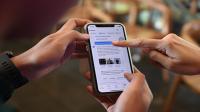Video Is the new phone call
05:22:12 | 15 Nov 2021

SINGAPORE (IndoTelko) — Vonage announced new research revealing that about half (47%) of consumers worldwide have increased their use of digital channels to engage with businesses and service providers over the past 12-18 months and 87 percent expect to maintain or increase this level in the next 6-12 months.
Here in Asia consumers have significantly increased their use of digital channels to engage with businesses and service providers since the outbreak of COVID-19 – 52 percent (retail & ecommerce), 51 percent (education), 49 percent (banking & finance), 46 percent (healthcare services), 43 percent (media, gaming & online dating) and 31 percent (transportation & travel). In the next 6-12 months, 44 percent will continue to increase their digital engagement with retail and ecommerce service providers, followed by education and banking & financial services (42%), healthcare (38%), media, gaming & online dating (36%) and transportation & travel (34%).
Vonage’s 10th Global Customer Engagement Report, based on a survey of 5,000 consumers from 14 countries, uncovered just how much the pandemic accelerated the global adoption of newer communications channels while increasing fragmentation in channel preferences, especially in the ways that consumers interact with organisations. The research highlights changes over the past two years that reinforce the need for businesses and service providers to transform their customer engagement strategies to become more agile and adapt to permanent changes accelerated by the COVID era.
Consumers who embraced new and emerging channels of communication during the pandemic did not revert back to old habits. Customer engagement has permanently changed and there will be no return to the pre-2020 era. The usage of digital channels (video, chatbots, non-SMS messaging apps, etc.) has grown considerably, while more traditional channels (mobile voice calls, email) have held steady.
"COVID-19 has fundamentally changed how businesses operate and how consumers interact with those organisations," said Joy Corso, Chief Marketing Officer for Vonage. "Our research shows that digital channels have rapidly emerged alongside traditional methods of communication, with sharp and sustained growth in video, chatbots, app-based messaging and calling, while email and traditional voice calls remain relatively status quo. This underscores the need to connect with and engage with customers in multiple ways, in their preferred modality. We are in an age where customers expect ultra-fast, seamless and dynamic communications and engagement.”
Vonage explored some of the customer service hurdles that surveyed consumers reported and the business impact of these frustrations. For example, 46 percent of consumers are very likely to stop buying from a business or using its services if their calls repeatedly go unanswered with no other channels available for help. This highlights the importance of secondary and tertiary choices for communication; offering another channel such as live chat can ensure that the customer’s needs are still met.
Video Is the New Phone Call
Since January 2020, globally, there has been a 300 percent growth in the number of people who prefer to connect with businesses via video. Three in five consumers worldwide are video chatting with a business or service provider more now than they were 18 months ago, and four in five expect their video chats with friends and family to stay the same (55%) or increase even further (35%) during the next six months. Additionally: Consumers are using video chat to connect with healthcare services 50 percent more today than they were during the outbreak of COVID-19 in 2020.
With the advent of widespread distance learning, 37 percent of consumers prefer video chat when learning and studying remotely with a tutor.
At work, 38 percent of respondents favor video calls when collaborating with their team or customers on an important project. Digital engagement while working increased for at least half of respondents in each region. APAC saw a 65 percent increase since the start of the pandemic.
The Might of the Messaging Apps
Emerging communications channels that saw an increase in preference include messaging via social messaging apps and chatbots. Consumer preference for messaging apps has doubled since the outbreak of COVID-19. Additionally, consumers now use and prefer WhatsApp both to call and text more than any other messaging channel, beating even SMS and Facebook Messenger. In fact, WhatsApp is now 160 percent more popular than SMS. 27% of users prefer to use WhatsApp to communicate with a service provider, making it the preferred messaging app in Asia, followed by SMS (22%), WeChat (16%) and Line (14%). Businesses must always be agile and ready to adapt to changes in the market, but the pandemic made the call for agility even louder. While a remote delivery of services is crucial to business survival today, that ability will mean little if the experience isn’t frictionless, seamless and embedded into the applications customers are already comfortable using. Organisations that meet consumers on their communications channel of choice, while limiting frustrations, may emerge from this turbulent era stronger than before. Thinca, Japan-based provider of cloud-based CTI solution, KAIKURA, has been able to enhance its CRM solution and meet its customers’ desire for omnichannel communications, via the Vonage SMS API and Vonage Video API. "Business communication needs are constantly evolving and that has only accelerated more so since the start of the pandemic. Our customers rely on us for seamless and effective tools to improve work processes, enhance customer experience and stay connected with their stakeholders through omnichannel communications,” said Takahiro Ejiri, CEO of Thinca.(es)
Baca juga :
•
•
•
Since January 2020, globally, there has been a 300 percent growth in the number of people who prefer to connect with businesses via video. Three in five consumers worldwide are video chatting with a business or service provider more now than they were 18 months ago, and four in five expect their video chats with friends and family to stay the same (55%) or increase even further (35%) during the next six months. Additionally: Consumers are using video chat to connect with healthcare services 50 percent more today than they were during the outbreak of COVID-19 in 2020.
With the advent of widespread distance learning, 37 percent of consumers prefer video chat when learning and studying remotely with a tutor.
At work, 38 percent of respondents favor video calls when collaborating with their team or customers on an important project. Digital engagement while working increased for at least half of respondents in each region. APAC saw a 65 percent increase since the start of the pandemic.
Emerging communications channels that saw an increase in preference include messaging via social messaging apps and chatbots. Consumer preference for messaging apps has doubled since the outbreak of COVID-19. Additionally, consumers now use and prefer WhatsApp both to call and text more than any other messaging channel, beating even SMS and Facebook Messenger. In fact, WhatsApp is now 160 percent more popular than SMS. 27% of users prefer to use WhatsApp to communicate with a service provider, making it the preferred messaging app in Asia, followed by SMS (22%), WeChat (16%) and Line (14%). Businesses must always be agile and ready to adapt to changes in the market, but the pandemic made the call for agility even louder. While a remote delivery of services is crucial to business survival today, that ability will mean little if the experience isn’t frictionless, seamless and embedded into the applications customers are already comfortable using. Organisations that meet consumers on their communications channel of choice, while limiting frustrations, may emerge from this turbulent era stronger than before. Thinca, Japan-based provider of cloud-based CTI solution, KAIKURA, has been able to enhance its CRM solution and meet its customers’ desire for omnichannel communications, via the Vonage SMS API and Vonage Video API. "Business communication needs are constantly evolving and that has only accelerated more so since the start of the pandemic. Our customers rely on us for seamless and effective tools to improve work processes, enhance customer experience and stay connected with their stakeholders through omnichannel communications,” said Takahiro Ejiri, CEO of Thinca.(es)
Artikel Terkait
-
 English Ver. - 04:06:00 | 25 Aug 2025The collaboration is designed to simplify complex payment processes for global travel businesses
English Ver. - 04:06:00 | 25 Aug 2025The collaboration is designed to simplify complex payment processes for global travel businesses -
 English Ver. - 04:07:00 | 11 Aug 2025Wireless Logic has completed the acquisition of Zipit Wireless
English Ver. - 04:07:00 | 11 Aug 2025Wireless Logic has completed the acquisition of Zipit Wireless -
 English Ver. - 05:00:00 | 27 Jul 2025JLL’s involvement included identifying and securing a site that met DAMAC’s technical and strategic requirements
English Ver. - 05:00:00 | 27 Jul 2025JLL’s involvement included identifying and securing a site that met DAMAC’s technical and strategic requirements
Rekomendasi
Berita Pilihan
More Stories
PR Newswire








.jpeg)
















































